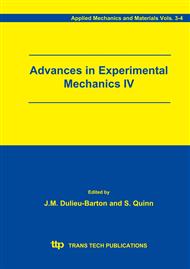p.65
p.71
p.79
p.85
p.91
p.99
p.105
p.111
p.117
Material Identification Using a Bi-Axial Test Machine
Abstract:
This paper shows the identification of material parameters for a DC06 IF steel sheet of 0.8 mm by mechanical tests. The experimental equipment used consists of a tensile test machine, a bi-axial test machine able to perform plane-strain and simple shear tests separately or simultaneously and an optical strain gauge. Tensile, plane-strain and simple shear tests were performed at 0°, 45° and 90° from the sheet rolling direction in order to identify Hill 1948 and Hosford 1979 yield criteria. Two identification methods are used: one based on strain measurements (anistropy coefficients) and the other one based on stress measurements (plastic contours). The results confirm that mechanical tests applying other stress-states than tensile are required to obtain accurate material parameters identification.
Info:
Periodical:
Pages:
91-98
Citation:
Online since:
August 2006
Authors:
Price:
Сopyright:
© 2005 Trans Tech Publications Ltd. All Rights Reserved
Share:
Citation:


